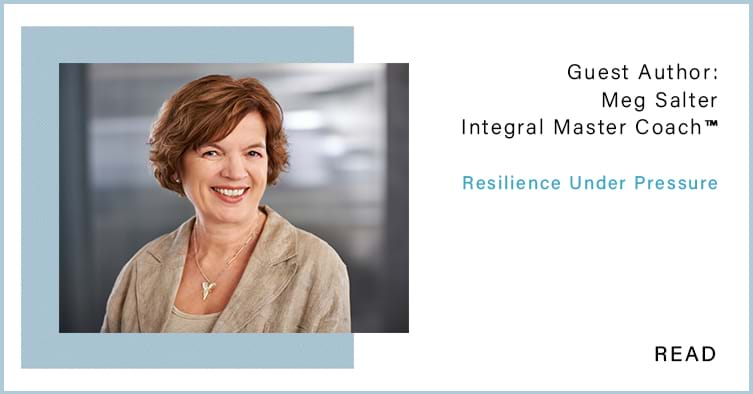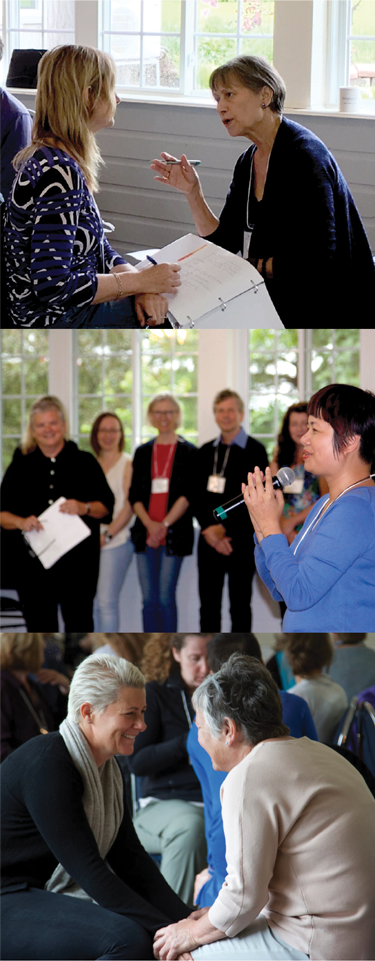

Resilience Under Pressure

ICC's Preamble: We're so thrilled to be sharing Meg Salter's contribution of this guest post and to be announcing her newly released book! Meg is on faculty with ICC as one of our esteemed Phone Coaches, is an Integral Master Coach™ and the author of the book Mind Your Life: How Mindfulness Can Build Resilience and Reveal Your Extraordinary. A few words on the work follows, and then the main article that tackles the link between mindfulness and resilience.
id you ever wonder how different people respond to similar stresses quite differently? Especially if it wasn’t you? Whether it’s a layoff, an illness or a troubled relationship, some people just seem to bounce back better than others. Part of the answer lies in our own personal resilience. This ability to bounce back can make the difference between normal stress that encourages growth and distress that renders us stuck or overwhelmed.
Resilience is the ability to recover, adapt and grow in response to threat or challenge.
Resilience comes in part from your physical health and your social network of friends and family who can support you when you need it. And resilience is also an internal capacity you can develop. Resilient people do experience negative emotions and stress; but they have learned to navigate around and through crises. You don’t need to constantly throw yourself into high stress situations to boost your resilience. There’s an easier way. You can practice mindfulness.
Mindfulness as a Resilience Booster
Mindful ness works like a vaccine that supports resilience for the mind and emotions. Medical vaccines build physical resilience by inserting a small safe dose of what otherwise might be harmful into the body, stimulating the immune system so that the body can ward off disease. Mindfulness works along similar principles. You undertake practices that can initially feel odd or counter-intuitive. You practice in safe, low-risk ways. In doing so, you stimulate the natural recovery and growth mechanisms of the human mind and emotions. Resilience muscles that you build while meditating become strong enough to kick in naturally in daily life, when the stakes are high and you need them the most.
ness works like a vaccine that supports resilience for the mind and emotions. Medical vaccines build physical resilience by inserting a small safe dose of what otherwise might be harmful into the body, stimulating the immune system so that the body can ward off disease. Mindfulness works along similar principles. You undertake practices that can initially feel odd or counter-intuitive. You practice in safe, low-risk ways. In doing so, you stimulate the natural recovery and growth mechanisms of the human mind and emotions. Resilience muscles that you build while meditating become strong enough to kick in naturally in daily life, when the stakes are high and you need them the most.
In Mind Your Life, I outline seven muscles of resilience. Let’s review one of them now.
Resilience as the Ability to Stay Focused Under Pressure
When faced with a challenge, a resilient person is able to stay focused on the task at hand. Can you remember a high-pressure moment, right now? A difficult conversation, a looming deadline, or a big game? I can still remember my Integral Coaching® Mastery Certification panel review, seven years ago now. Whew—talk about pressure!
In these high-pressure moments. we know what we want to do, but we can also experience anxieties, doubts, fears or physical tensions. These worries and tensions can be so strong, they overwhelm us. We feel swamped. We “lose our nerve” and don’t perform to the best of our actual abilities.
So how does mindfulness practice build the ability to stay focused? Let’s use a basic instruction for mindfulness on the breath. (Breath meditation is by no means the only way to practice mindfulness—Mind Your Life shows you many more—but the basic principles remain the same.)
“Focus your awareness on your breath, staying attentive to the sensations of inhalation and exhalation, and start again at the next breath. Do not judge your breathing or attempt to change it in any way. See anything else that comes to your mind as a distraction; let distractions go and return your attention to the breath.”
Mindfulness practice involves repeated acts of focus. Just look at the first words of the instruction. “Focus your awareness on the breath… Start again at the next breath.”
This is the core skill of concentration. You learn that your attention doesn’t just happen. It is a faculty you can intentionally direct, as you choose. This choice of focus can be as narrow as the breath at the tip of your nose or as wide as all your sensory experience.

 In mindfulness practice, you learn the ability to stay focused on what you deem is relevant at any given time, when you’re not under pressure, so that you can stay focussed when you need it the most in daily life. Think of the skill of concentration like playing pool, directing your attention to the call-pocket of your choice.
In mindfulness practice, you learn the ability to stay focused on what you deem is relevant at any given time, when you’re not under pressure, so that you can stay focussed when you need it the most in daily life. Think of the skill of concentration like playing pool, directing your attention to the call-pocket of your choice.
Concentration as Selective Attention
What comes.jpg) to mind when you think of someone concentrating? Perhaps it’s a tennis player focusing intently on her opponent, oblivious to any background noise. Or a business professional, shoulders hunched, staring at his screen, working furiously toward a looming deadline. We often think of concentration as being narrowly focused, unbroken over a long time, during which we tense up to suppress everything we’re not concentrating on. No wonder it doesn’t sound appealing!
to mind when you think of someone concentrating? Perhaps it’s a tennis player focusing intently on her opponent, oblivious to any background noise. Or a business professional, shoulders hunched, staring at his screen, working furiously toward a looming deadline. We often think of concentration as being narrowly focused, unbroken over a long time, during which we tense up to suppress everything we’re not concentrating on. No wonder it doesn’t sound appealing!
In mindfulness, concentration is not about controlling the content of what you experience or suppressing anything in that experience. It is the skill of selective attention, consciously choosing where you direct your attention. Normally we associate concentration with focus and its inevitable by-product of tightening and tension. We think we can be either focused or relaxed, but not both. States of high concentration based on selective attention are characterized by both focus and calm, relaxation and alertness.
Try this simple exercise in concentration.
Gaze at this picture:

There are actually two images hidden in the picture. Which image do you see first, the horn player, or the woman’s face? (Hint: the woman’s left eye is also the horn player’s chin.)
Now focus your attention on the image that you did not notice first. I.e. If you first noticed the horn player, place your attention on the woman’s face. If you find the horn player jumping back at you, just refocus your attention on the face. Repeat this process as much as you need to over a period of several minutes.
Notice that neither the foreground or background disappeared, but you were selectively directing your attention.
Resilience as Focus And Calm
The next time you’re feeling the need to remain focused under pressure, remember these key points:
Direct your attention. It could be to anything; a mental task, a visual sight, involve you alone or many people, be straight-forward or ambiguous. It could engender pleasant feelings like confidence, or not. Consider this as the foreground of your attention.
Keep your focus on this selected foreground. Don’t try to make everything else disappear. Trying to do this is just a waste of your precious energy. To the best of your ability, keep your focus on what you deem relevant in the foreground and let any worries or tensions play themselves out in the background.
Re-focus. From time to time, what’s in the background will overwhelm what’s in the foreground. Over and over, re-focus your attention where you intend.Bring a learning mentality. With practice, this re-focusing gets easier. You learn to interpret distraction not as a failure of attention but an opportunity to build the resilience muscles of persistence and focus.
Bringing a learning mentality (beginner’s mind) means you don’t beat yourself up, thereby adding to your already considerable pressures.
Want to explore a deeper dive into Mindfulness and building resilience, check out Mind Your Life.
Click here to learn more about Meg Salter and her work.
Like it? Share it!





 Download
Download Share
Share


